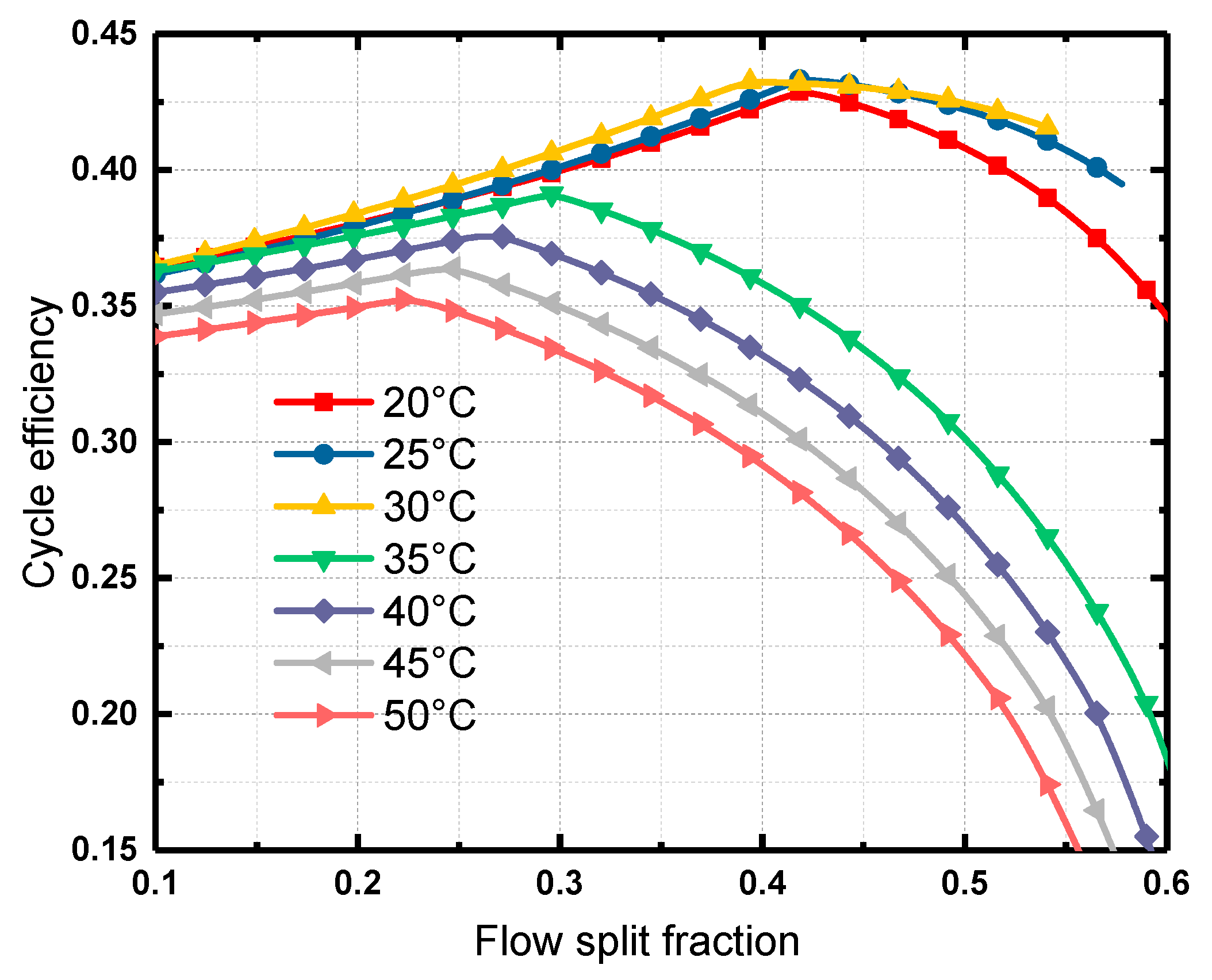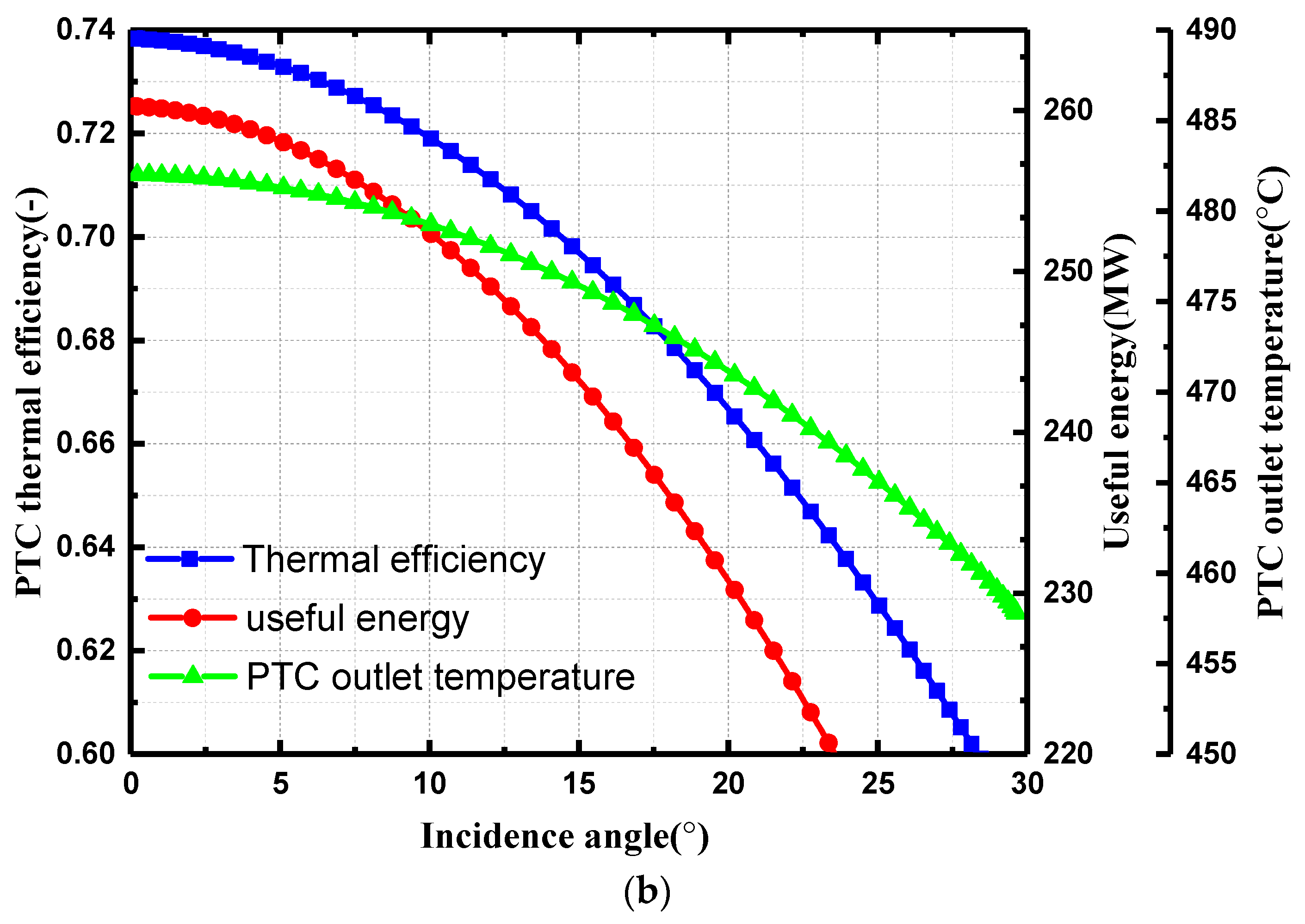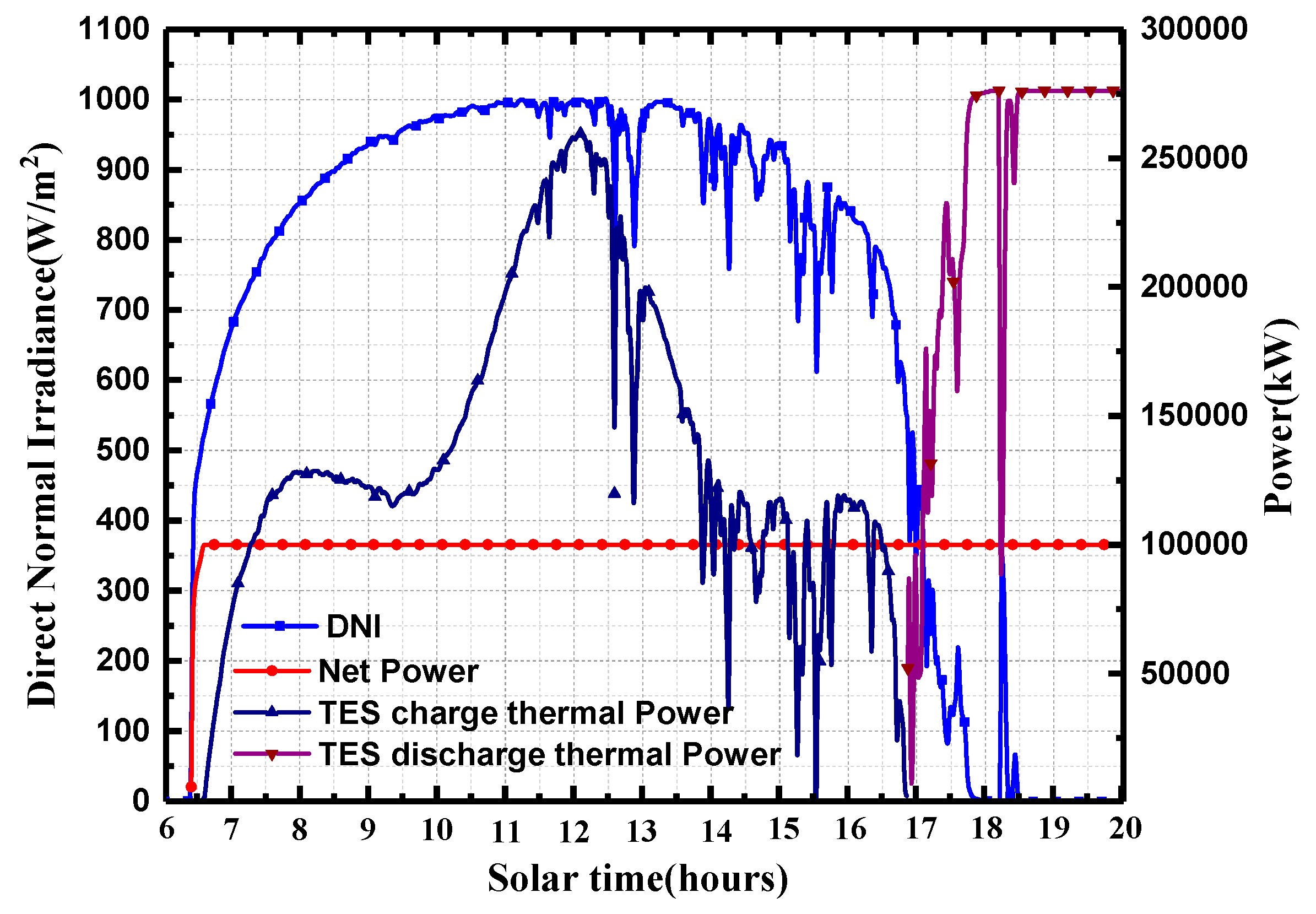Thermal Performance Analysis of a Direct-Heated Recompression Supercritical Carbon Dioxide Brayton Cycle Using Solar Concentrators
Abstract
:1. Introduction
2. System Configuration
3. System Model
4. Results and Discussion
4.1. Thermodynamic Analysis of the Recompression Brayton-Cycle
4.2. Operation Analysis of Parabolic Trough Solar Collector
4.3. Combined Performance Analysis of PTC s-CO2 Brayton Cycle
5. Conclusions
Supplementary Materials
Author Contributions
Funding
Acknowledgments
Conflicts of Interest
Nomenclature
| Acronyms | |
| CSP | concentrating solar thermal power |
| HTF | heat transfer fluid |
| PTC | parabolic trough solar collector |
| DSG | direct steam generation |
| CO2 | carbon dioxide |
| s-CO2 | supercritical carbon-dioxide |
| ORC | organic Rankine cycle |
| HT | hot tank |
| CT | cool tank |
| PRC | pre-cooler |
| LTR | low temperature recuperator |
| HTR | high temperature recuperator |
| MC | main compressor |
| RC | recompressing compressor |
| T | turbine |
| G | generator |
| FS | flow split |
| FM | flow merge |
| PR | pressure ratio |
| SCA | solar collector assembly |
| Symbols | |
| A | area (m2), solar azimuth (°) |
| cp | specific heat (kJ/kg-K) |
| length of collector assembly (m) | |
| y | split ratio factor |
| Greek letters | |
| w | aperture width (m) |
| ρ | density (kg/m3); reflectance |
| focal length (m) | |
| Efficiency (-) | |
| Subscripts | |
| geo | geometry defects |
| tr | tracking error |
| m | mirror |
| dy | mirror soiling |
| gen | general error |
| r | reflective |
Appendix A. Technical Parameters
| Geometry defects, | 0.98 |
| Tracking error, | 0.99 |
| Mirror reflectance, | 0.935 |
| Mirror soiling, | 0.97 |
| General error, | 0.97 |
| Length of collector assembly, | 100 m |
| Aperture width, | 5.75 m |
| Focal length, | 2.11 m |
| Reflective aperture, Ar | 545 m2 |
| Concentrating ratio (-) | 82 |
| Number of array assemblies | 778 |
| Absorber tube inner diameter | 0.076 m |
| Absorber tube outer diameter | 0.08 m |
| Glass envelope inner diameter | 0.115 m |
| Glass envelope outer diameter | 0.12 m |
| Internal surface roughness | 0.000045 |
| Absorber absorptivity | 0.995 |
| Absorber thermal emittance | 0.095 at 400 °C |
| Glass transmittance | 0.965 |
| Vacuum | ≤10−3 mbar |
| Specific heat, ( | |
| Thermal conductivity, k () | |
| Density, (kg/m3) | |
| Operational temperature range | 239 °C–600 °C |
| Compressor inlet Temperature | 31.25 °C |
| Compressor outlet pressure | 20 MPa |
| Compressor inlet pressure | 7.4 MPa |
| Pressure ratio, PR | 2.7 [-] |
| Compressor isentropic efficiency | 0.89 [-] |
| Re-compressor isentropic efficiency | 0.89 [-] |
| Turbine isentropic efficiency | 0.995 [-] |
| Net mechanical power output | 100 MW |
References
- Al-Nimr, M.A.; Qananba, K.S. A solar hybrid system for power generation and water distillation. Sol. Energy 2018, 171, 92–105. [Google Scholar] [CrossRef]
- Lam, M.K.; Tan, K.T.; Lee, K.T.; Mohamed, A.R. Malaysian palm oil: Surviving the food versus fuel dispute for a sustainable future. Renew. Sustain. Energy Rev. 2009, 13, 1456–1464. [Google Scholar] [CrossRef]
- Lund, P.D.; Mikkola, J.; Ypyä, J. Smart energy system design for large clean power schemes in urban areas. J. Clean. Prod. 2015, 103, 437–445. [Google Scholar] [CrossRef]
- Jamel, M.; Abd Rahman, A.; Shamsuddin, A. Advances in the integration of solar thermal energy with conventional and non-conventional power plants. Renew. Sustain. Energy Rev. 2013, 20, 71–81. [Google Scholar] [CrossRef]
- Law, E.W.; Kay, M.; Taylor, R.A. Calculating the financial value of a concentrated solar thermal plant operated using direct normal irradiance forecasts. Sol. Energy 2016, 125, 267–281. [Google Scholar] [CrossRef]
- Solangi, K.H.; Islam, M.R.; Saidur, R.; Rahim, N.A.; Fayaz, H. A review on global solar energy policy. Renew. Sustain. Energy Rev. 2011, 15, 2149–2163. [Google Scholar] [CrossRef]
- Khan, J.; Arsalan, M.H. Solar power technologies for sustainable electricity generation—A review. Renew. Sustain. Energy Rev. 2016, 55, 414–425. [Google Scholar] [CrossRef]
- Fernández, A.G.; Gomez-Vidal, J.; Oró, E.; Kruizenga, A.; Solé, A.; Cabeza, L.F. Mainstreaming commercial CSP systems: A technology review. Renew. Energy 2019, 140, 152–176. [Google Scholar] [CrossRef]
- Giostri, A.; Binotti, M.; Astolfi, M.; Silva, P.; Macchi, E.; Manzolini, G. Comparison of different solar plants based on parabolic trough technology. Sol. Energy 2012, 86, 1208–1221. [Google Scholar] [CrossRef]
- Wang, Y.; Liu, Q.; Lei, J.; Jin, H. Performance analysis of a parabolic trough solar collector with non-uniform solar flux conditions. Int. J. Heat Mass Transf. 2015, 82, 236–249. [Google Scholar] [CrossRef]
- Wang, J.; Wang, J.; Bi, X.; Wang, X. Performance simulation comparison for Parabolic trough solar collectors in China. Int. J. Photoenergy 2016, 2016, 1–16. [Google Scholar] [CrossRef]
- Llamas, J.M.; Bullejos, D.; de Adana, M.R. Optimization of 100 MWe Parabolic-Trough Solar-Thermal Power Plants Under Regulated and Deregulated Electricity Market Conditions. Energies 2019, 12, 3973. [Google Scholar] [CrossRef]
- Price, H.; Lupfert, E.; Kearney, D.; Zarza, E.; Cohen, G.; Gee, R.; Mahoney, R. Advances in Parabolic Trough Solar Power Technology. J. Sol. Energy Eng. 2002, 124, 109–125. [Google Scholar] [CrossRef]
- Yang, Z.; Garimella, S.V. Thermal analysis of solar thermal energy storage in a molten-salt thermocline. Sol. Energy 2010, 84, 974–985. [Google Scholar] [CrossRef]
- Montes, M.J.; Abánades, A.; Martinez-Val, J.M. Thermofluidynamic model and comparative analysis of parabolic trough collectors using oil, water/steam, or molten salt as heat transfer fluids. J. Sol. Energy Eng. 2010, 132, 021001. [Google Scholar] [CrossRef]
- Kearney, D.; Herrmann, U.; Nava, P.; Kelly, B.; Mahoney, R.; Pacheco, J.; Cable, R.; Potrovitza, N.; Blake, D.; Price, H. Assessment of a molten salt heat transfer fluid in a parabolic trough solar field. J. Solar Energy Eng. 2003, 125, 170–176. [Google Scholar] [CrossRef]
- Fraidenraich, N.; Oliveira, C.; da Cunha, A.F.; Gordon, J.M.; Vilela, O.C. Analytical modeling of direct steam generation solar power plants. Sol. Energy 2013, 98, 511–522. [Google Scholar] [CrossRef]
- Feldhoff, J.F.; Schmitz, K.; Eck, M.; Schnatbaum-Laumann, L.; Laing, D.; Ortiz-Vives, F.; Schulte-Fischedick, J. Comparative system analysis of direct steam generation and synthetic oil parabolic trough power plants with integrated thermal storage. Sol. Energy 2012, 86, 520–530. [Google Scholar] [CrossRef]
- Hirsch, T.; Feldhoff, J.F.; Hennecke, K.; Pitz-Paal, R. Advancements in the Field of Direct Steam Generation in Linear Solar Concentrators—A Review. Heat Transf. Eng. 2014, 35, 258–271. [Google Scholar] [CrossRef]
- Marefati, M.; Mehrpooya, M.; Shafii, M.B. Optical and thermal analysis of a parabolic trough solar collector for production of thermal energy in different climates in Iran with comparison between the conventional nanofluids. J. Clean. Prod. 2018, 175, 294–313. [Google Scholar] [CrossRef]
- Kasaeian, A.; Daviran, S.; Azarian, R.D.; Rashidi, A. Performance evaluation and nanofluid using capability study of a solar parabolic trough collector. Energy Convers. Manag. 2015, 89, 368–375. [Google Scholar] [CrossRef]
- Bellos, E.; Tzivanidis, C.; Antonopoulos, K.A.; Gkinis, G. Thermal enhancement of solar parabolic trough collectors by using nanofluids and converging-diverging absorber tube. Renew. Energy 2016, 94, 213–222. [Google Scholar] [CrossRef]
- Al-Nimr, M.A.; Al-Dafaie AM, A. Using nanofluids in enhancing the performance of a novel two-layer solar pond. Energy 2014, 68, 318–326. [Google Scholar] [CrossRef]
- Cakici, D.M.; Erdogan, A.; Colpan, C.O. Thermodynamic performance assessment of an integrated geothermal powered supercritical regenerative organic Rankine cycle and parabolic trough solar collectors. Energy 2017, 120, 306–319. [Google Scholar] [CrossRef]
- Ashouri, M.; Razi Astaraei, F.; Ghasempour, R.; Ahmadi, M.H.; Feidt, M. Thermodynamic and economic evaluation of a small-scale organic Rankine cycle integrated with a concentrating solar collector. Int. J. Low-Carbon Technol. 2015, 12, 54–65. [Google Scholar] [CrossRef]
- Iodice, P.; Langella, G.; Amoresano, A. Modeling and energetic-exergetic evaluation of a novel screw expander-based direct steam generation solar system. Appl. Therm. Eng. 2019, 155, 82–95. [Google Scholar] [CrossRef]
- Li, P.; Li, J.; Tan, R.; Wang, Y.; Pei, G.; Jiang, B.; Tang, J. Thermo-economic evaluation of an innovative direct steam generation solar power system using screw expanders in a tandem configuration. Appl. Therm. Eng. 2019, 148, 1007–1017. [Google Scholar] [CrossRef]
- Singh, R.; Miller, S.A.; Rowlands, A.S.; Jacobs, P.A. Dynamic characteristics of a direct-heated supercritical carbon-dioxide Brayton cycle in a solar thermal power plant. Energy 2013, 50, 194–204. [Google Scholar] [CrossRef]
- Ahn, Y.; Bae, S.J.; Kim, M.; Cho, S.K.; Baik, S.; Lee, J.I.; Cha, J.E. Review of supercritical CO2 power cycle technology and current status of research and development. Nucl. Eng. Technol. 2015, 47, 647–661. [Google Scholar] [CrossRef]
- Dawson, L.A.; Rochau, G.E.; Carlson, M.D.; Mendez Cruz, C.M.; Fleming, D.D. Supercritical CO2-Brayton Cycle-Potential Benefits Applications Technology Development Status and Future Plans. (No. SAND2016-8202C); Sandia National Lab, 2016. Available online: https://www.osti.gov/servlets/purl/1378068 (accessed on 1 November 2019).
- Dostal, V. A Supercritical Carbon Dioxide Cycle for Next Generation Nuclear Reactors. Ph.D. Thesis, Massachusetts Institute of Technology, Cambridge, MA, USA, 2004. [Google Scholar]
- Dostal, V.; Hejzlar, P.; Driscoll, M.J. The supercritical carbon dioxide power cycle: Comparison to other advanced power cycles. Nucl. Technol. 2006, 154, 283–301. [Google Scholar] [CrossRef]
- Moisseytsev, A.; Sienicki, J.J. Investigation of alternative layouts for the supercritical carbon dioxide Brayton cycle for a sodium-cooled fast reactor. Nucl. Eng. Des. 2009, 239, 1362–1371. [Google Scholar] [CrossRef]
- Feher, E.G. The supercritical thermodynamic power cycle. Energy Convers. 1968, 8, 85–90. [Google Scholar] [CrossRef]
- Angelino, G. Carbon dioxide condensation cycles for power production. J. Eng. Power 1968, 90, 287–295. [Google Scholar] [CrossRef]
- Sarkar, J. Second law analysis of supercritical CO2 recompression Brayton cycle. Energy 2009, 34, 1172–1178. [Google Scholar] [CrossRef]
- Alzahrani, A.A.; Dincer, I. Energy and exergy analyses of a parabolic trough solar power plant using carbon dioxide power cycle. Energy Convers. Manag. 2018, 158, 476–488. [Google Scholar] [CrossRef]
- Wang, K.; He, Y.L. Thermodynamic analysis and optimization of a molten salt solar power tower integrated with a recompression supercritical CO2 Brayton cycle based on integrated modeling. Energy Convers. Manag. 2017, 135, 336–350. [Google Scholar] [CrossRef]
- Al-Sulaiman, F.A.; Maimoon, A. Performance comparison of different supercritical carbon dioxide Brayton cycles integrated with a solar power tower. Energy 2015, 82, 61–71. [Google Scholar] [CrossRef]
- Padilla, R.V.; Too, Y.C.; Benito, R.; Stein, W. Exergetic analysis of supercritical CO2 Brayton cycles integrated with solar central receivers. Appl. Energy 2015, 148, 348–365. [Google Scholar] [CrossRef]
- Solé, A.; Miró, L.; Barreneche, C.; Martorell, I.; Cabeza, L.F. Corrosion of metals and salt hydrates used for thermochemical energy storage. Renew. Energy 2015, 75, 519–523. [Google Scholar] [CrossRef]
- Lund, P.D.; Lindgren, J.; Mikkola, J.; Salpakari, J. Review of energy system flexibility measures to enable high levels of variable renewable electricity. Renew. Sustain. Energy Rev. 2015, 45, 785–807. [Google Scholar] [CrossRef] [Green Version]
- Lemmon, E.; Huber, M.; McLinden, M. NIST thermodynamic and transport properties of refrigerants and refrigerant mixtures (REFPROP) version 8.0. NIST Stand. Ref. Database 2007. [Google Scholar]
- Delingha 50 MW Thermal Oil Parabolic Trough Project. Available online: https://solarpaces.nrel.gov/delingha-50mw-thermal-oil-parabolic-trough-project (accessed on 12 November 2019).
- SUPCON Delingha 50 MW Tower. Available online: https://solarpaces.nrel.gov/supcon-delingha-50-mw-tower (accessed on 12 November 2019).
- Giostri, A.; Binotti, M.; Silva, P.; Macchi, E.; Manzolini, G. Comparison of two linear collectors in solar thermal plants: Parabolic trough versus Fresnel. J. Sol. Energy Eng. 2013, 135, 011001. [Google Scholar] [CrossRef]
- Poullikkas, A. Economic analysis of power generation from parabolic trough solar thermal plants for the Mediterranean region—A case study for the island of Cyprus. Renew. Sustain. Energy Rev. 2009, 13, 2474–2484. [Google Scholar] [CrossRef]
- Gilman, P.; Dobos, A. System Advisor Model, SAM 2011.12. 2, General Description; National Renewable Energy Lab. (NREL): Golden, CO, USA, 2012. [CrossRef] [Green Version]
- Burkholder, F.; Kutscher, C. Heat Loss Testing of Schott’s 2008 PTR70 Parabolic Trough Receiver; National Renewable Energy Lab. (NREL): Golden, CO, USA, 2009. [CrossRef]
- Zavoico, A.B. Solar Power Tower Design Basis Document; Sandia National Laboratories: Albuquerque, NM, USA, 2001.
- Dyreby, J.; Klein, S.; Nellis, G.; Reindl, D. Design considerations for supercritical carbon dioxide Brayton cycles with recompression. J. Eng. Gas Turbines Power 2014, 136, 101701. [Google Scholar] [CrossRef]
- Moisseytsev, A.; Sienicki, J.J. Performance Improvement Options for the Supercritical Carbon Dioxide Brayton Cycle; No. ANL-GENIV-103, Argonne National Lab. (ANL): Argonne, IL, USA, 2008. [Google Scholar] [CrossRef] [Green Version]











| Turbine Outlet Pressure [MPa] | Maximum Cycle Efficiency [-] | Optimized Flow Split Fraction [-] |
|---|---|---|
| 16 | 0.4079 | 0.3816 |
| 18 | 0.4085 | 0.3571 |
| 20 | 0.4059 | 0.3327 |
| 22 | 0.4033 | 0.3204 |
| 24 | 0.3996 | 0.3082 |
| 26 | 0.3953 | 0.2959 |
| 28 | 0.3905 | 0.2837 |
| 30 | 0.3862 | 0.2837 |
| 32 | 0.3817 | 0.2714 |
| Turbine Inlet Temperature [°C] | Maximum Cycle Efficiency [-] | Optimized Flow Split Fraction [-] |
|---|---|---|
| 350 | 0.2987 | 0.3327 |
| 400 | 0.3431 | 0.3327 |
| 450 | 0.3810 | 0.3327 |
| 500 | 0.4137 | 0.3449 |
| 550 | 0.4432 | 0.3327 |
| 600 | 0.4693 | 0.3449 |
| Compressor Inlet Temperature [°C] | Maximum Cycle Efficiency [-] | Optimized Flow Split Fraction [-] |
|---|---|---|
| 20 | 0.4289 | 0.4184 |
| 25 | 0.4318 | 0.4184 |
| 30 | 0.4323 | 0.4061 |
| 35 | 0.3912 | 0.2959 |
| 40 | 0.3758 | 0.2592 |
| 45 | 0.3638 | 0.2469 |
| 50 | 0.3524 | 0.2224 |
© 2019 by the authors. Licensee MDPI, Basel, Switzerland. This article is an open access article distributed under the terms and conditions of the Creative Commons Attribution (CC BY) license (http://creativecommons.org/licenses/by/4.0/).
Share and Cite
Wang, J.; Wang, J.; Lund, P.D.; Zhu, H. Thermal Performance Analysis of a Direct-Heated Recompression Supercritical Carbon Dioxide Brayton Cycle Using Solar Concentrators. Energies 2019, 12, 4358. https://doi.org/10.3390/en12224358
Wang J, Wang J, Lund PD, Zhu H. Thermal Performance Analysis of a Direct-Heated Recompression Supercritical Carbon Dioxide Brayton Cycle Using Solar Concentrators. Energies. 2019; 12(22):4358. https://doi.org/10.3390/en12224358
Chicago/Turabian StyleWang, Jinping, Jun Wang, Peter D. Lund, and Hongxia Zhu. 2019. "Thermal Performance Analysis of a Direct-Heated Recompression Supercritical Carbon Dioxide Brayton Cycle Using Solar Concentrators" Energies 12, no. 22: 4358. https://doi.org/10.3390/en12224358





